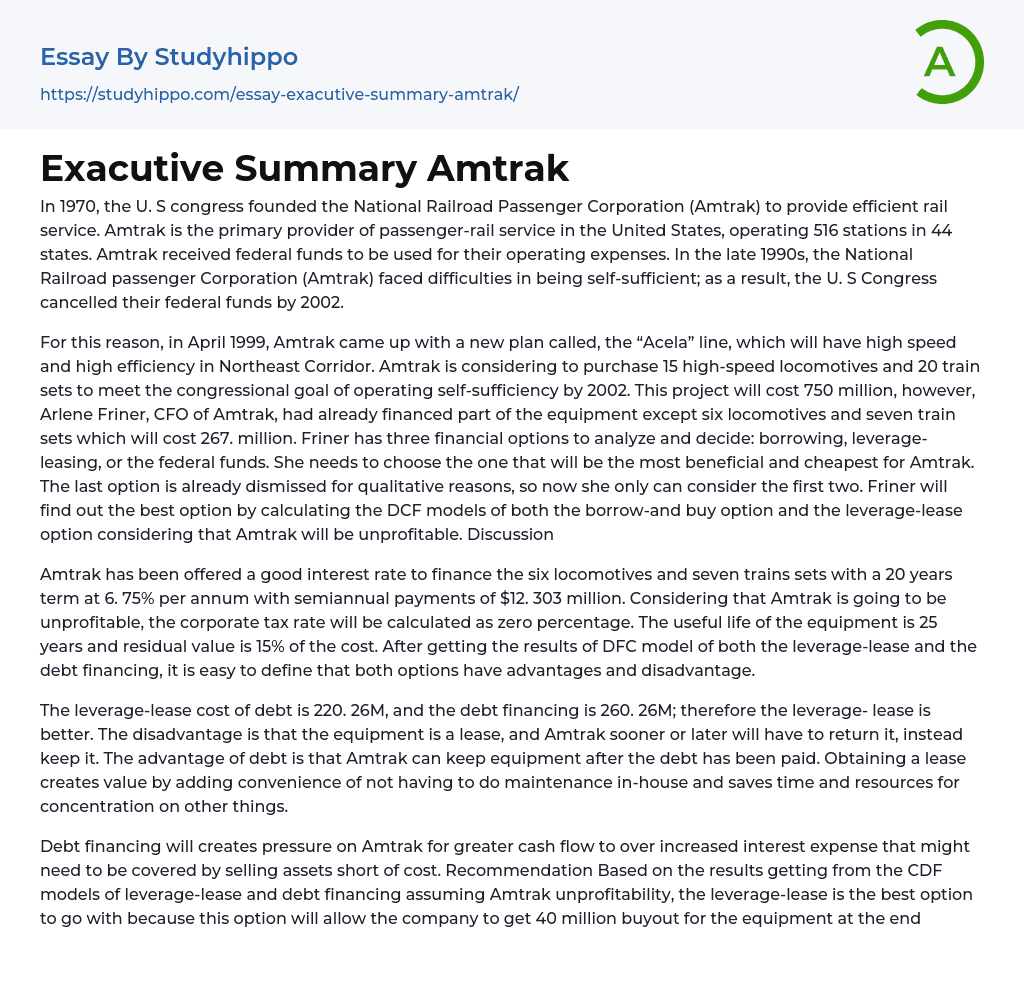Established in 1970 by the U.S Congress, Amtrak, also known as the National Railroad Passenger Corporation, was given the responsibility of providing dependable railway services. As a premier provider of passenger rail services, it operates across 44 states and oversees 516 stations. Initially reliant on federal funding for operational costs, Amtrak faced financial hardships while trying to achieve self-sustainability during the late '90s. Consequently, its federal funding was halted by the U.S Congress in 2002.
In April 1999, Amtrak introduced a new initiative referred to as the “Acela” line. This line was set to provide high-speed and efficient train services in the Northeast Corridor. To help meet the congressional objective of self-operation by 2002, Amtrak planned on purchasing 15 high-speed locomotives along with 20 train sets. This scheme would be an
...investment of approximately 750 million dollars. Nevertheless, Arlene Friner, the CFO of Amtrak, has already funded most of this equipment barring six locomotives and seven train sets, which add up to 267 million dollars. At this juncture, Friner has three financial pathways to explore and select from: obtaining loans, leveraging lease agreements or opting for federal funds. She needs to identify an option that will be most cost-effective and advantageous for Amtrak. The final option has already been ruled out due to qualitative factors, leaving her with the first two alternatives. Friner will determine the superior choice by assessing the Discounted Cash Flow (DCF) models of both borrowing to buy and leveraging lease options, assuming Amtrak's lack of profitability. Discussion.
Amtrak has secured a favorable interest rate for the procurement of six locomotives and seven train sets, to be pai
over two decades at an annual interest rate of 6.75% with semi-annual payments amounting to $12.303 million. Given Amtrak's projected operating deficit, it is assumed that there will be no corporate tax imposed. The lifespan of the equipment acquired is expected to span 25 years with a salvage value estimated at 15% of its initial cost upon expiry. After analyzing outcomes from the DFC model for both options - leverage lease and debt financing, it was noted that each option comes with its own advantages and disadvantages.
The cost of leverage-lease debt stands at 220.26M, whereas the debt financing amounts to 260.26M, making the former a more favourable option. One downside, however, is that the equipment acquired through this lease would eventually have to be returned by Amtrak instead of being retained. On the other hand, the benefit of debt financing is that Amtrak can retain ownership of the equipment after repayment. Opting for a lease can generate value by providing convenience through eliminating the need for internal maintenance and freeing up time and resources to focus on other aspects.
The requirement for larger cash flows due to the pressure from debt financing might necessitate Amtrak to sell assets below cost in order to offset increased interest expenses. According to the results derived from CDF models of leverage-lease and debt financing with the assumption of Amtrak's loss-making situation, the leverage-lease emerges as the most advantageous option. This approach will enable Amtrak to receive a $40 million buyout for its equipment at the end of the lease term, making it a less costly and more beneficial option for the company.
- American Literature essays
- Between The World and Me essays
- Book Report essays
- Book Review essays
- Book Summary essays
- Books essays
- Character essays
- Coming of Age essays
- Dante's Inferno essays
- Everyday Use essays
- Flowers for Algernon essays
- Genre essays
- Greek Mythology essays
- Incidents in The Life of a Slave Girl essays
- Letter essays
- Literary Criticism essays
- Literary devices essays
- Literature Review essays
- Metaphor essays
- Myth essays
- Play essays
- Plot essays
- Poem essays
- Poetry Analysis essays
- Protagonist essays
- Reader essays
- Reason essays
- Rhetoric essays
- Rhetorical Question essays
- Rhyme essays
- Simile essays
- Tragic Hero essays
- Translation essays
- Understanding essays
- Utopia essays
- Villain essays
- Writer essays
- Bank essays
- Banking essays
- Corporate Finance essays
- Credit Card essays
- Currency essays
- Debt essays
- Donation essays
- Enron Scandal essays
- Equity essays
- Financial Accounting essays
- Financial Crisis essays
- Financial News essays
- Financial Ratios essays




